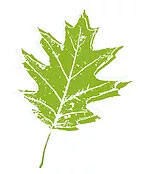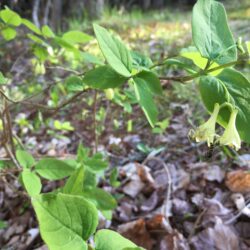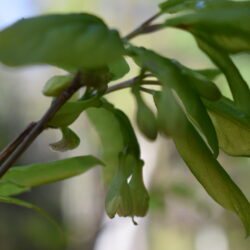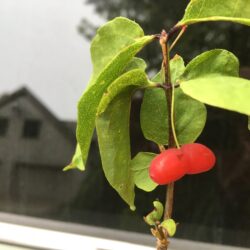Etymology
Lonicera is from Latin for the 16th century German physician-herbalist Adam Lonitzer; canadensis is Greek, referring to northern.
Native Habitat
Woodlands.
Garden Uses
American fly honeysuckle is happily under a mixed canopy, such as a woodland garden. It is one of the first shrubs to bloom at the beginning of May.
Overview
A native of northeastern woodlands, this deciduous shrub enjoys well-drained forest edges and cool, open woodlands. It leafs out and flowers earlier than other understory plants, making it specially evident in spring. Habitat is challenged by introduced, invasive honeysuckles, but this species is more shade tolerant than the non-natives.
Leaves and Stems
Blunt or pointed, somewhat egg-shaped leaves are simple, smooth, opposite, growing two per node, and 1" to 3-1/2" long and 1" wide. Edges are fringed with fine hairs, which may also be seen on the lower surface. Leaves appear simultaneously with flowers. Young bark of stems is green, purplish, or reddish-brown, and hairless. Older bark is grey and tends to peel in strips. Winter buds have 3 overlapping scales. Branches often straggle and may self-root to form clones.
Flowers
Bell-shaped flowers hang in pairs at the tips of 1-year old branches. Each pair is on a slender, hairless 1" stalk that arises from a leaf axil. Flowers are pale yellow, and may be tinged with purple. Each is less than 1" long, with 5 flared lobes joined at a tubular base. Five yellow stamens and a style with a spherical stigma all protrude past the bell. The green ovary ball is at the base of the bell.
Fruit/Seed
A fleshy pair of bright red oval berries, about 1/3" long, follow flowering. The 2 berries point in opposite directions.
Wildlife Associates
American fly honeysuckle attracts early spring pollinators, including some bees and Sphingidae (sphinx, clearwing, or hawk moths). Berries attract woodland birds such as brown thrashers, ruffed grouse and warblers.
Propagation
Pick the ripe fruit in July, before the birds notice it. Squish it in a zip lock bag, wash and plant immediately under a thin layer of course sand. Water regularly. Seeds typically sprout in 1 month. Grow protected in a pot for the first year.
Ethnobotanical Uses
None identified.
Anecdotal Information
Blooms much earlier than the non-native honeysuckles. Fruits are easily distinguished by their oblong shape versus the spherical-shaped fruit of the non-native species.
Sources
Plant Profile by Kate O'Dell



